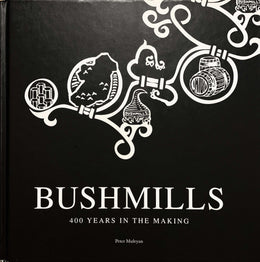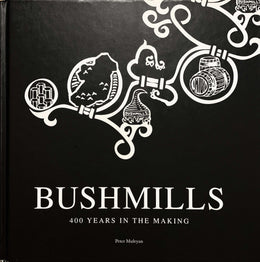Dropping in on Highland Park; "Orkney Stories: A specially commissioned collection by Highland Park"
Tom Morton is a familiar name and voice to newspaper readers and radio listeners in Scotland. His visit to Highland Park was to trigger off a highly entertaining tour of Scottish whisky distilleries, recounted in his book, The Spirit of Adventure

(Image Source: The Whisky Guide)

I fancied just turning up at Highland Park anonymously, but when I telephoned to find out the opening times, it turned out the distillery was closed to visitors for the refurbishment of the reception centre. I asked to speak to the manager. 'Look,' I said. 'I'm a reporter, I'm in town, and I wondered if I could have a chat about a book I'm thinking of doing about whisky. Maybe you could tell me a bit about Highland Park.'
Within half an hour I was nursing an enormous dram in Jim Robertson's office, neither his youth nor his bluff, north of England accent quite what I expected. What I received from Jim, though, was considerably more than a dram. It was a personal, more than somewhat biased foundation course in whisky-making.
To make whisky, what you need, basically, is barley, water and a fuel source, preferably peat. Making the barley is mostly done at industrial maltings like Moray Firth Maltings in Inverness or Ord at Muir of Ord. But I knew that Highland Park malted its own barley in traditional floor making barns, just the way it has since 1798. Pretty damn impressive, Jim, I ventured, wanting to display my knowledge.
`To be honest, we only do 20 percent of our own malting. Hardly anybody does 100 percent malting anymore and nobody does it with 100 per cent Scottish barley all the time. But from our point of view the 20 percent we do is vital. The floor malting is very gentle on the malt, and we look after it individually.'
He illustrates this with a quick tour round the maltings. It's simply stunning, with the great quiet lakes of germinating barley spread out after their two or three days' soaking in the steep tanks. Old-fashioned wooden barrows, called chariots, are used to spread it out, and it is regularly turned by hand. Two cats patrol for any extraneous creatures, their names, whimsically enough, are Malt and Barley. 'They earn their keep,' says Jim.
But not as much as Billy does. Billy is a kilnsman, and we find him like some mythical firemaster, shovelling peat into the flames of the kiln. 'I've been here over thirty years,' he says, 'and my father before me. He's fine, by the way,' he tells Jim. 'But they won't let him have his dram in the hospital.' We all shake our heads over this woeful injustice.
‘Some say they can taste heather in Highland Park,' says Jim, 'and there are stories of heather being thrown in with peat to give it that taste. Back in the nineteenth century, there was supposedly a heather house, so maybe they burned heather then. Nowadays the peat we use is itself pretty heathery in its top section, but that's all. Some of it is black, some of it is heathery.'
‘I've never seen heather being burned, anyway,' says Billy. 'mind you, I've seen great lumps of heather-root being thrown in along with the peat, stuff the peat-cutting machine churns up. Never bothered too much about it. It just comes along with the peat.'
In fact, coke is the main fuel for Highland Park's kilns. 'Basically the peat's for flavour,' says Jim. 'We get the kiln up to temperature with coke and then we use peat for twelve hours. After that the peat reek doesn't stick to the grain anyway, so there's no point in doing it any longer. You're just wasting your time.'
Attempts have been made to imitate the Highland Park malt on a commercial scale off the islands, but all have failed, even when using the distillery's own Hobbister peat. So the distinctive pagodalike chimneys of Highland Park are likely to survive for a while, and as more than a tourist attraction. It must be said that seeing Billy or one of his colleagues labouring in the flickering peat-light is an unforgettable experience. Like being given a guided tour of one of hell's more welcoming dungeons.

(Image Source: Xtra Wine)
Highland Park, however, is not generally to be compared with Hades. It is an immaculate place. The old-fashioned maroon-painted iron of the Porteous malt-mill shines. The new Lauter mash-tun — 'the only bit of stainless steel in the place' — sits in machined splendour, ready to churn around the sugary mash of crushed malt and water. The huge larch washbacks have recovered from their role in the Second World War as baths for Canadian troops stationed at Scapa Flow, and now the wort ferments away without interference from bodily bacteria. The copper pot-stills gleam dully just as stills are supposed to; the spirit cage, the locked brass-and-glass box which prevents any unscrupulous person sampling the cratur before duty has been paid on it, glints in yellow perfection. There are two wash stills, where the eight per cent alcohol is distilled into 20 percent low wines. Then there are two spirit stills, which produce the final magic.
`Everybody says you need soft water to make good whisky.' Jim Robertson likes to explode whisky myths. Trained as an industrial engineer, he is mostly a scientist, and only partly a reluctant alchemist. 'We've got very hard water, so there goes another piece of nonsense. I believe, however, that it's very hard to improve on traditional methods, on the whole.'
The casks I smelt were indeed sherry casks, but Highland Park matures in used bourbon casks too. Charred on the inside, it used to be illegal in America, Jim tells me, to re-use the oak barrels, so they were sold cheaply to Scotland. Now they are like gold dust, and distilleries pull all sorts of barrelesque tricks: knocking together old bits of cask, wine treatment, or simply using oak, which means the resultant whisky can be virtually colourless. How does your dram get that nice brown colour, then, if not from the cask ? Amazing what you can do with a bit of caramelised sugar.
Not at Highland Park, though. 'We use a mixture of sherry and bourbon casks. Obviously they give different characters and flavours, but it's not just the whisky from one cask that goes into a bottle. There is a mixing. We mix different flavours, different colours to get the match for bottling a consistent product.'
So what makes Highland Park special? For Jim, it's everything in the process, although he admits that the maturing in the Orkney environment may be crucial.
`Ten, twelve, fourteen years in this kind of special climate must make a difference. It's different from Islay, from Speyside. It's even different from Scapa, just down the hill. And inevitably it's different from what it might have been fifty or a hundred years ago. Whisky is an organic product. it changes, just as the water, the peat, the air and the grain change with time.'
I'd tasted Highland Park twelve-year-old often, but that bitterly cold afternoon, drinking it at the distillery itself was something of a religious experience. As Neil Gunn says, and him an excise officer too, whisky is the warming spirit for the cold northern temperament. Everyone, cold and northern or not, should try it, preferably on an Orkney winter's day with the snow flurrying outside, and fresh from the sight of a roaring making kiln being loaded with peat. You can taste the peat, all right. You can even taste the heather. After a few, you can taste just about anything you damn well like.

I told Jim about my idea for a book about whisky, maybe something a bit irreverent, a bit wild, a bit, well, down-market. Wasn't it about time the old buffers had such a precious commodity as malt wrested from them? Shouldn't a (slightly) younger generation get to wrap their lips around a bottle or two? Jim was pessimistic.
‘I don't think we're particularly succeeding in attracting the younger drinker,' he said. The problem is that the younger palate doesn't quite appreciate the flavours. As you get older, you tend to appreciate less sweet drinks, like red wine as opposed to white. When I was younger I hated red wine. Whisky's a bit like that.'
Well, maybe. I took my leave from Jim still convinced that the market for malts was certain to open out to the less tweedy consumer.
Malt whisky was just begging to become a megafashionable cult. Little did I know that in Continental Europe it had already done so.
Anyway, if proof were required of how masterworks like Highland Park knock everyday blends — those combinations of mostly cheap industrial grain whisky and dozens of young malts — into the proverbial urinal, it was on the wall of Jim Robertson's office. It was a letter from Troon, in Ayrshire, the town I was raised in. The address was Piersland Lodge, which is now a luxury hotel but which used to be a Christian guest house. Winston Churchill once stayed there, but that was when it was owned by the Walker family, not when it was a Christian guest house. The Walkers, that is, as in Johnnie Walker. The Whisky Walkers of Kilmarnock and elsewhere. The letter, dated 1914, was from Allan Walker. This is what is said:
Many, many thanks for the two bottles of twenty-year- old Highland Park. I have duly sampled one, and am in the process of conversion to the idea that HP is the only whisky worth drinking, and Johnnie Walker only fit for selling to deluded Sassenachs.
My point precisely.
Of course, in the days before 1798 when Highland Park became a licensed distillery, it was the site for Magnus Eunson's antics in 'smuggling', as illicit distilling was known. A United Presbyterian church officer, he was wont to hide his supplies under the pulpit of the kirk, and according to Alfred Barnard, in one of his less boring passages, 'was accustomed to give out the psalms in a more unctuous manner than usual if the excise officers were in the church, as he knew he was suspected.' Hearing, one day, that the church was to be searched, Eunson had all the kegs hidden under a clean, white cloth in his own house, a coffin lid added to complete the effect. When the customs officers arrived, having discovered nothing in the church, they found Eunson and his household kneeling solemnly around the `body', weeping and wailing for all their worth. When the dread word `smallpox' was whispered in the customs chief's ear, they hotfooted it out.
Religion, deception and the true spirit of Orkney come together nicely in what is almost certainly just a yarn. But it's a good yarn, and one that bears repetition, even if people sometimes repeat it about the wrong distillery, in the wrong part of Scotland, using names other than Eunson. But that's oral history for you.
Written by Tom Morton
The text is an excerpt from "Orkney Stories: A specially commissioned collection by Highland Park" (pp. 7 - 12), published 1995 by Matthew Gloag & Son Limited under the commission of Highland Park Single Malt Scotch Whisky.







